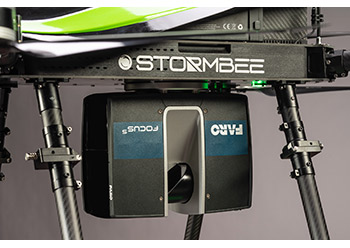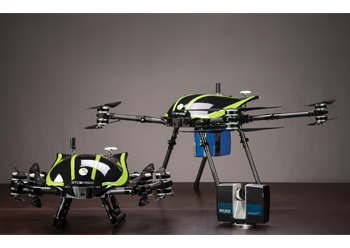Faro scanner gives flight to 3D CAD models
Laser scanners from Faro helped create the world’s first high-precision 3D scanning drone, thanks to their lightweight, portability and use-friendliness.
01 July 2020
Belgian firm Think 3D has been using drones fitted with Faro laser scanners to provide 3D CAD models for complex industrial installations from different sectors such as petrochemicals, steel, pharmaceuticals and the food industry.
In fact, when it first decided on the scanners for these applications, the company made the radical choice to build the drone around the Faro Laser Scanner instead of choosing a scanner that fits an existing drone – this was thanks to its conviction of the scanning qualities of these laser scanners.
3D scanning for industrial environments has been done ever since the 3D laser scanner was invented. “However, scanning with a fixed solution often provided problems; technicians often had to do dangerous climbs to be able to scan everything, machines had to stop working. Think 3D has found the solution by combining the Faro Focus3D X130 with a drone to create the world’s first high-precision 3D scanning drone,’’ says a spokesman for Faro, among the world’s most trusted sources for 3D measurement, imaging and realisation technology.
 |
|
Stormbee utilises Faro’s lightweight, portable and use-friendly laser scanners. |
Think 3D is called in when companies want to make changes to their installations and need a full 3D CAD model of their installation. The customers can then use this model as they please, to give to the architect, add to specifications or to create a 3D tour of the facility with.
“From the start, we have been using the Faro Focus3D X130 to perform the scans,” CEO Liesbeth Buyck reveals. “One advantage of the Focus was that it was very accurate in comparison to other models, but the main advantage was that it was lightweight, portable and use-friendly. As we continuously had to move in between industrial infrastructures, we needed a scanner that could fit in narrow spaces and could also be set up and used in a minimal amount of time.”
During their different scans of industrial and factory sites, Buyck found a fundamental drawback in the scanning of these sites. “The main problem was that making 3D models of industrial sites is incredibly time-consuming if done from a stationary position because of two reasons. First of all, the scanning equipment has to be moved around all the time to get all angles of the facility to ensure a complete 3D model – in certain cases even stopping the whole production line to avoid deviations. Secondly, the work after the scans is again time-consuming, as at the end they also have to link all the different point clouds together to create a singular model,” he explains.
To increase productivity in these cases, Buyck thought of linking the Faro Focus3D X130 with a drone for easy manoeuvrability. “At that time, drones were becoming readily available on the market and we saw the advantage that it could mean for our scanning tasks.
“By combining a drone and a laser scanner, you are decreasing the time cost twofold. On the one hand, the drone does not have to be moved and you can make one complete point cloud in a single flight. This way, we were able to deliver the requested 3D model to our clients much faster than a company that does fixed scans as we are now able to deliver the point cloud within a 24-hour time frame in most cases,” he explains.
As Think 3D was already convinced about the scanning qualities of the Faro Focus3D X130, it made the radical choice to change the way of construction: it chose to build the drone around the Faro Focus. To research if the drone could be equipped with the laser scanner of Faro, extra expertise was needed. Think 3D combined a team of specialists in aerospace, aviation and UAV (unmanned aerial vehicle) technology. After a four-year research period, Stormbee was born. The UAV makes it possible to use all types of Faro laser scanners.
“The slightest gust of wind can destabilise the drone, thus impacting the accuracy of the scan. Of course, we understand that if you place a laser scanner on a drone that there will always by a certain level of deviation, however, it is our task to see how we can bring back that deviation to the bare minimum,” Buyck explains.
The possibility to personalise the UAV results in a unique concept.
“We see tremendous potential in this project and offering it to other interested parties. At the end of the day, all companies choose to be as productive as possible and this unique combination of the Faro Focus3D X130 and our specially developed drone is the key to making this happen,” he concludes.
Think 3D provides state-of-the-art 3D laser scanning and 3D modelling for the industrial market. Constantly searching for innovative solutions to provide clients with best results, Think 3D has succeeded in utilisng drones for various services it offers. Because of the accuracy, the speed and the range of the Faro laser scanners that Think 3D uses, the company is able to provide a 3D model of any indoor and outdoor site on short notice and according to the individual requirements of each customer.
According the Faro spokesman, there are at least four good reasons for opting for the company’s laser scanners:
- Accuracy: In comparison to other laser scanners, the Faro Focus is extremely accurate and reliable.
- Portability and speed: The scanner needs to fit in narrow spaces and be set up and used in a minimal amount of time: Faro Laser Scanner Focus3D X 130 perfectly satisfies these demands.
- Flexibility: The Faro Focus laser scanners can be combined with a drone to increase productivity significantly.
- Faro scanner gives flight to 3D CAD models
- JobSight monitors projects remotely
- Yovza platform aims to revolutionise workflows
- Voice-based automation boost for Bentley



